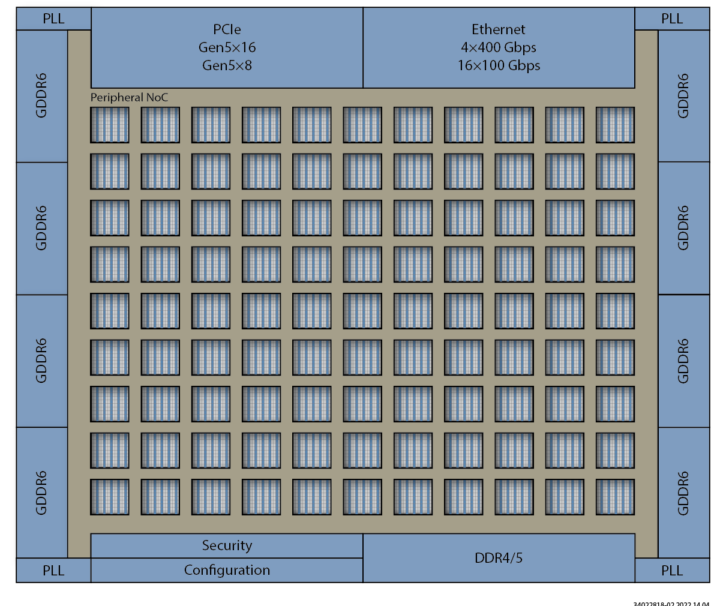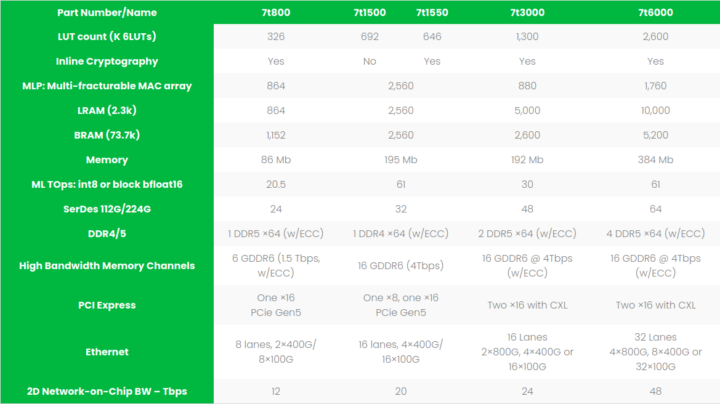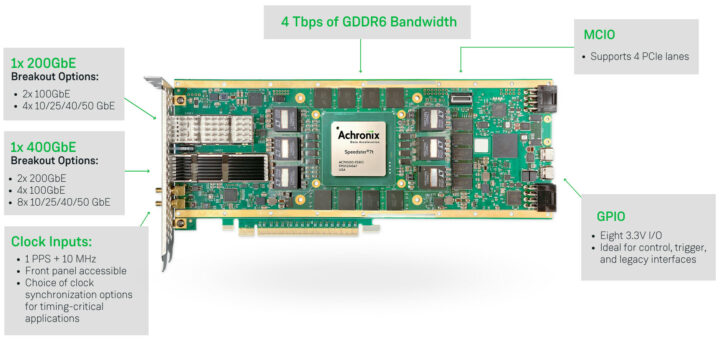Achronix Semiconductor has recently announced the general availability of the Speedster7t AC7t1500 FPGA designed for networking, storage, and compute (AI/ML) acceleration applications.
The 7nm Speedster7t FPGA family offers PCIe Gen5 ports and GDRR6 and DDR5/DDR4 memory interfaces, delivers up to 400 Gbps on the Ethernet ports, and includes a 2D network on chip (2D NoC) that can handle 20 Tbps of total bandwidth.

Achronix Speedster7t highlights:
- Two-dimensional network on chip (2D NoC) enabling high bandwidth data flow throughout and between the FPGA fabric and hard I/O and memory controllers and interfaces
- MLP (Machine Learning Processors) blocks with arrays of multipliers, adder trees, accumulators, and support for both fixed and floating-point operations, including direct support for Tensorflow’s bfloat16 format and block floating-point (BFP) format.
- Multiple PCIe Gen5 ports
- High-speed SerDes transceivers, supporting 112 Gbps PAM4 and 56 Gbps PAM4/NRZ modulation, as well as lower data rates
- Hard Ethernet MACs that support up to 400 Gbps
- GDDR6 and DDR5 SDRAM controllers and interfaces (Note: the Speedster7t AC7t1500 supports DDR4 rather than DDR5)
- Security
- Fabric-based bi-directional cryptographic engine (Speedster7t AC7t1550)
- Hard bi-directional cryptographic engine (Speedster7t AC7t800 and others)
- Logic architecture with 6-input LUTs (6LUT), 8-bit ALUs, flip-flops, and a reformulated multiplier LUT (MLUT) mode based on a modified Booth’s algorithm, which doubles the performance of LUT-based multiplication
- Fabric routing enhanced with dedicated bus routing and active bus muxing
- 72 kb BRAM and 2 kb LRAM memory blocks
- GPIO supporting multiple I/O standards
- PLLs and DLLs to support multiple, on-chip clock trees
- Multiple types of programming interfaces
- Partial reconfiguration of the FPGA fabric
- Remote update of the FPGA fabric
- Security features for encrypting and authenticating bitstreams
- Debug support through Achronix Snapshot
There are five parts in the Speedster7t product matrix with the 7t1500 with 692K LUTs now in mass production and the entry-level 7t800 with 326 LUTs having just been added to Achronix Tool Suite. The higher-end 7t3000 and 7t6000 parts must be planned for the future as they are not listed in the datasheet yet.
I could not find any typical development board for the Speedster7t FPGAs, but the company provides the VectorPath S7t-VG6 accelerator card based on the 7t1500 FPGA. It is designed for the development of high-performance compute and acceleration functions for artificial intelligence (AI), machine learning (ML), networking, and data center applications.
Main interfaces and specifications:
- FPGA – Speedster7t AC7t1500 FPGA
- System Memory
- GDDR6 – 16 GB, 8 banks with two independent 16-bit channels per bank
- One bank of DDR4 – 2666 MHz with ECC, up to 4 GB (×72)
- Storage – Flash memory for booting FPGA
- PCI SIG certified to support PCIe Gen4 x16 host interface
- 1x QSFP-DD cage – 1x 400GbE, 2x 200GbE, 4x 100GbE, or 8x 10/25/40/50 GbE
- 1x QSFP56 cage – 1x 200GbE, 2x 100GbE, or 4x 10/25/40/50 GbE
- 8x GPIO
- MCIO – connected to FPGA via four transceivers supporting up to PCIe Gen5 data rates
The Achronix Tool Suite is used for all Achronix FPGAs and eFPGA IP solutions and comes with the company’s ACE design tools and Synopsys Synplify-Pro for the synthesis of FPGA designs. Achronix simulation libraries are supported by Mentor Graphics ModelSim, Synopsys VCS, and Aldec Riviera-PRO, and the suite also includes the Snapshot Debugger real-time design debugging tool. The design flow should be straightforward to FPGA designers used to working on competing FPGA with support for VHDL and Verilog input, and industry-standard simulation.
Additional information may be found on the product page and press release.
Thanks to TLS for the tip.

Jean-Luc started CNX Software in 2010 as a part-time endeavor, before quitting his job as a software engineering manager, and starting to write daily news, and reviews full time later in 2011.
Support CNX Software! Donate via cryptocurrencies, become a Patron on Patreon, or purchase goods on Amazon or Aliexpress







Hmmm, should I buy an FPGA or a new car? Decisions, decisions….
QSFP56-DD Transceiver 4x1310nm ~$950
MCIO (Gen5) 0.5m(to 1.0m) ~$95
Impressive specs. This will probably end up in multi-100G switches with line-rate ACL capabilities!
Before getting eager, this product and variants are discussed on the internet since 2018, 2019. A few seconds internet search revealed to me.
Make as you wish from my statements
🎄⛄
“The design flaw should be straightforward to FPGA designers”: I would guess you mean “design flow” 🙂
Appears to be first time u mention this company. I take it this blows the water out of lattice, another fpga you covered. It’d be nice so see real life applications, details comparisons. xilinx, speedster, lattice, etc etc.
Yes, it’s the first time I cover the company. The Speedster7t is a higher-end FPGA with 676K LUTs and high-speed interfaces and will target different use cases/applications than the mid-range Lattice Avant with up to ~500K logic cells.
When David above says “should I buy an FPGA or a new car?”, he’s only half kidding, as some FPGAs are sold in the price range of a car.
> some FPGAs are sold in the price range of a car
and that’s normal. Usually they’re sold in small series, and can be used to build data planes for routers and switches that are sold up to 10 times the price of a car sometimes.
When I first started as a software engineer I worked on an FPGA board simulating a processor, and I blew it up not once but twice by confusing the ADSL and Ethernet cables, both connected to RJ45 jacks somehow. My boss was not happy complaining each board costs $50,000 to make.
Lack of replaceable fuses in modern tech IMO. 🤔